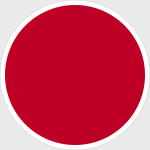Hobby Master HA3403 Japanese Air Self-Defense Force Mitsubishi T-2 Trainer - "Blue Impulse", 21st Squadron, 4th Air Wing, Hamamatsu, Shizuoka, Japan (1:72 Scale)
"Obsolete weapons do not deter."
- British Prime Minister Margaret Thatcher
 The Mitsubishi F-1 is Japan's first, post WWII, domestically developed jet fighter, and was the first fighter to enter production in Japan since the end of World War II. Mitsubishi Heavy Industries and Fuji Heavy Industries jointly developed the F-1. At first glance, it resembles the French/Anglo SEPECAT Jaguar, but was a completely independent Japanese effort (although it uses the same engines).
The Mitsubishi F-1 is Japan's first, post WWII, domestically developed jet fighter, and was the first fighter to enter production in Japan since the end of World War II. Mitsubishi Heavy Industries and Fuji Heavy Industries jointly developed the F-1. At first glance, it resembles the French/Anglo SEPECAT Jaguar, but was a completely independent Japanese effort (although it uses the same engines).
In the mid 1960s, the Japan Air Self-Defense Force (JASDF) commenced studies into an advanced jet trainer which could also be modified to serve in the ground attack and anti-shipping roles. After considering license production of the T-38 Talon and SEPECAT Jaguar, Japan decided to develop its own trainer, the supersonic Mitsubishi T-2, this first flying on 20 July 1971. Cost over-runs in the T-2 program lead to the proposed single seat attack version almost being abandoned, but the cancellation of the Kawasaki P-XL, the planned replacement for Japan's Kawasaki P-2J maritime patrol aircraft freed-up funds, while making it important to keep Japan's aviation industry employed, and contracts were awarded for the development of the attack version as the FS-T2kai in 1973.
The new aircraft was a minimum change derivative of the T-2, with the rear cockpit being converted to an avionics bay by removing the rear seat, and replacing the canopy with a simple unglazed access hatch. Two additional hardpoints were fitted under the wing to allow carriage of a heavier weapon load, and the avionics were improved, with a new J/AWG-12 radar set, similar to that fitted in British Royal Air Force F-4M Phantom fighter jets. This set provides ranging information. Aside from the avionics changes, deletion of the rear seat, and new one-piece canopy, the only other major change from the T-2 was the beefing up of the aircraft to enable it to carry a larger weapons load than the T-2. The F-1 is fitted with an internally-mounted 20 mm JM61A1 Vulcan cannon with 750 rounds of ammunition. The aircraft also has seven external hardpoints for the carriage of a wide variety of stores. The fuselage hardpoint and inboard pair of underwing hardpoints are "wet", which means they can be used to carry external fuel tanks to increase the aircraft's range. The primary weapon of the F-1 is the ASM-1 and the newer ASM-2 long-range anti-ship missile. This weapon is roughly in the class of the American AGM-84 Harpoon or French AM.39 Exocet. Other weapons carried include the all-aspect short-range heat-seeking AIM-9 Sidewinder air-to-air missile for air-to-air combat. This weapon is carried on the wingtip rails usually, but it can also be carried on the outboard underwing hardpoints for the F-1's secondary air defense role. Other air-to-ground weapons carried include rocket pods (JLAU-3/A) of 70 mm (2.75 in) size as well as bombs of 227 kg (500 lb) and 340 kg (750 lb) in size (Mk82 and M117 respectively). In addition, the Mk-82 and M117 bombs can be fitted with infrared guidance kits, turning them into precision-guided weapons that home in on heat radiation emitted from seaborne targets such as ships or other ground-based targets. When fitted with this kit, the bomb becomes known as GCS-1.
The F-1 has slowly been replaced over the years by the newer F-2 (Japan/U.S. developed, based on F-16C/D), as well as upgraded F-4EJ "Kai" Phantom IIs. Units currently using the F-1 are scheduled to change over to the new F-2 over the next several years. One unit has already traded in its F-1s for F-4EJ Kais. Six F-1s based at Tsuiki in Fukuoka Prefecture were retired on March 9th, 2006, having reached the 4,000 hour limit of their airframes.
Pictured here is a 1:72 scale replica of a Japanese Air Self Defense Force Mitsubishi T-2 trainer that was assigned to the "Blue Impulse" aerobatic team attached to the 21st Squadron, 4th Air Wing.
Sold Out!
Dimensions:
Wingspan: 7-inches
Length: 8-inches
Release Date: September 2011
Historical Account: "Blue Impulse" - The Mitsubishi T-2 is a two-engined two-seat jet trainer manufactured by Mitsubishi Heavy Industries and was operated by the Japan Air Self Defense Force from 1975 - 2006. The flight instructor sat behind the student in a raised seat that allowed him to visually monitor the students actions. There was a wind blast screen between them that created separate clamshell canopies for each person. T-2s were also used by a dedicated Aggressor Squadrons until they were replaced by F-15 Eagle.
The Blue Impulse aerobatic demonstration team was founded in 1960. The first aircraft used was the F-86 Sabre until they re-equipped with the Mitsubishi T-2 in 1980. The team and their T-2s were located at Matsushima airbase from 1982 - 1995 as 4AW 21SQ Technical Research Section. In 1995 the T-2 was traded for the new Kawasaki T-4 trainer. The teams 175th performance using the T-2 was in December 1995. In 2003, the first of the T-2s were retired and the last one was in March 2006.






![USAAF North American P-51D Mustang Fighter - Capt. Roscoe C. Brown, Jr., 100th Fighter Squadron, 332nd Fighter Group "Tuskegee Airmen", Ramitelli, Italy, March 1945 [Signature Edition] (1:48 Scale)](http://cdn4.volusion.store/qh9e9-jdqv9/v/vspfiles/photos/HA7717A-1.jpg?v-cache=1740197136)
![Star Trek Federation Nova Class Starship - USS Equinox NCC-72381 [With Collector Magazine]](http://cdn4.volusion.store/qh9e9-jdqv9/v/vspfiles/photos/EMST0015-1.jpg?v-cache=1740197136)

